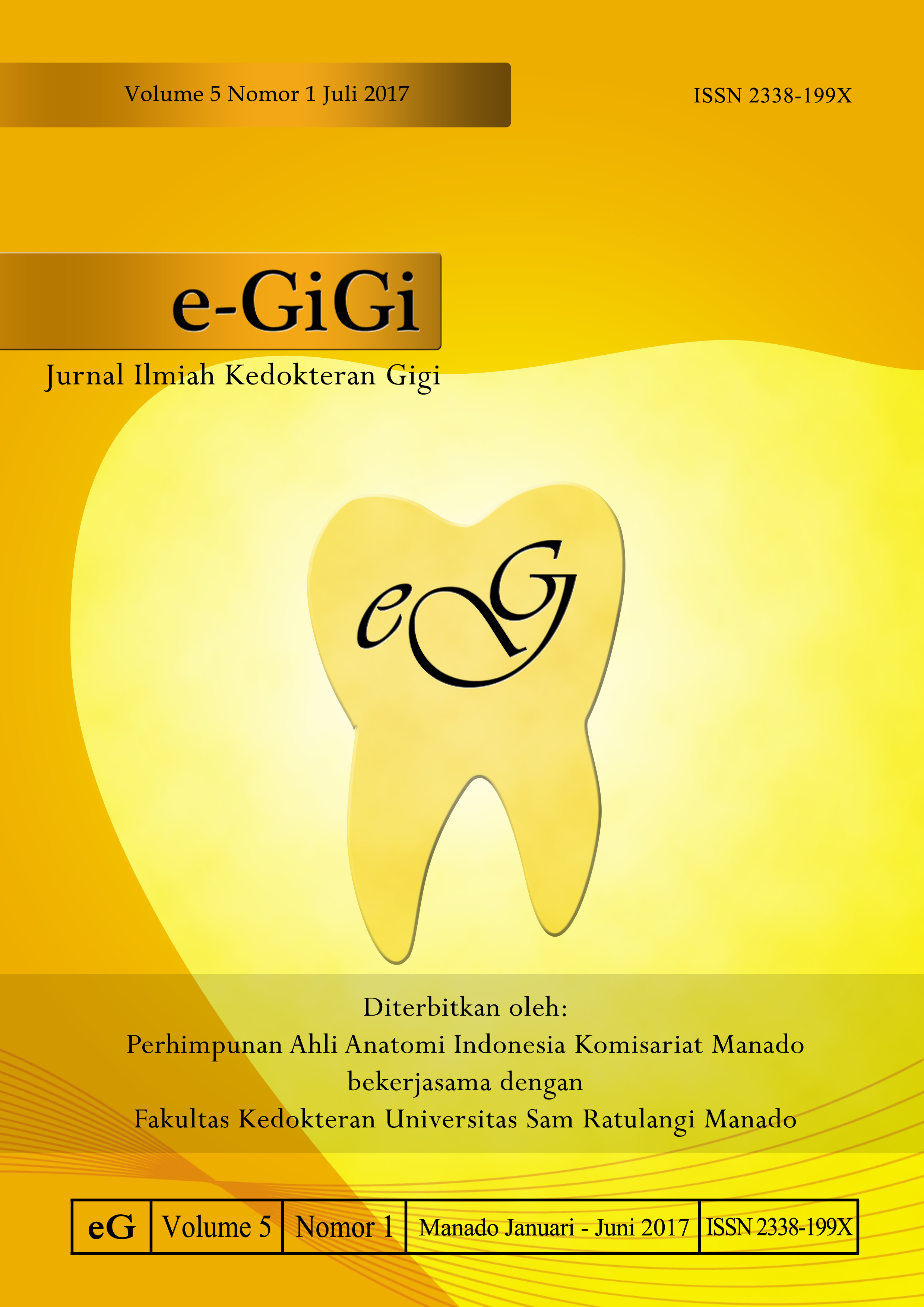Uji air perasan jeruk kesturi (Citrus microcarpa Bunge.) terhadap perubahan warna resin komposit yang direndam dalam larutan kopi
DOI:
https://doi.org/10.35790/eg.5.1.2017.14737Abstract
Abstract: Color change or discoloration of the tooth surface is an aesthetic problem that is often complained because it reduces one’s confidence in terms of appearance. This problem can also occur on the surface of restorative materials inter alia composite resin. Composite resin is a tooth-colored restorative material that most people favor due to its aesthetic value. This discoloration can occur due to excessive intake of colored beverages like coffee. The treatment used for discoloration is bleaching, but these treatments have side effects. Calamondin (Citrus microcarpa Bunge.) can be an alternative bleaching agent because it contatins citric acid. This study was aimed to determine whether calamondin juice could affect the color change of composite resin soaked in coffee solution. This was a pre-experimental study with a one shot case study design. Samples were 10 composite resins with a diameter of 5 mm and 2 mm thick soaked in coffee solution for 7 days to obtain discoloration and then samples were soaked in calamondin juice for 5 days to whiten the samples. The discoloration was measured by using the CIEL*a*b* method at 60 minutes and 5 days after soaking in calamondin juice. The Friedman test showed significant changes (p<0.05). Conclusion: Calamondin juice affected the color change of composite resin that had been soaked in coffee solution.
Keywords: composite resin, calamondin juice, color change
Â
Abstrak: Perubahan warna atau diskolorisasi pada permukaan gigi merupakan salah satu masalah estetika yang sering dikeluhkan karena mengurangi kepercayaan diri seseorang. Masalah ini juga dapat terjadi pada permukaan bahan tumpatan gigi, salah satunya adalah resin komposit. Resin komposit merupakan bahan tumpatan yang sewarna dengan gigi yang banyak digemari orang karena nilai estetiknya. Salah satu penyebab perubahan warna yaitu mengonsumsi minuman berwarna secara berlebih seperti kopi. Perawatan yang digunakan untuk masalah diskolorisasi ialah bleaching, namun perawatan ini memiliki efek samping. Jeruk kesturi (Citrus microcarpa Bunge.) dapat menjadi bahan alternatif bleaching karena karena mengandung asam sitrat. Penelitian ini bertujuan untuk mengetahui apakah air perasan jeruk kesturi berpengaruh terhadap perubahan warna resin komposit yang telah direndam dalam larutan kopi. Jenis penelitian ialah pre-eksperimental dengan one shot case study design. Penelitian ini menggunakan 10 sampel resin komposit dengan ukuran diameter 5 mm dan tebal 2 mm. Sampel direndam dalam larutan kopi selama 7 hari agar terjadi diskolorisasi kemudian direndam dalam air perasan jeruk kesturi selama 5 hari dengan tujuan untuk memutihkan kembali sampel. Pengukuran perubahan warna menggunakan metode CIEL*a*b dilakukan setelah perendaman 60 menit dan 5 hari. Uji Friedman menunjukkan terdapat perubahan bermakna (p<0,05). Simpulan: Air perasan jeruk kesturi berpengaruh terhadap perubahan warna resin komposit yang direndam dalam larutan kopi.
Kata kunci: resin komposit, air perasan jeruk kesturi, perubahan warna
Downloads
How to Cite
Issue
Section
License
COPYRIGHT
Authors who publish with this journal agree to the following terms:
Authors hold their copyright and grant this journal the privilege of first publication, with the work simultaneously licensed under a Creative Commons Attribution License that permits others to impart the work with an acknowledgment of the work's origin and initial publication by this journal.
Authors can enter into separate or additional contractual arrangements for the non-exclusive distribution of the journal's published version of the work (for example, post it to an institutional repository or publish it in a book), with an acknowledgment of its underlying publication in this journal.
Authors are permitted and encouraged to post their work online (for example, in institutional repositories or on their website) as it can lead to productive exchanges, as well as earlier and greater citation of the published work (See The Effect of Open Access).






